Summary
Alright, so you’ve got a brilliant business idea and now want to ask yourself the question “What is a pitch deck”. Pitch deck presentations are essential tools for introducing your business idea to potential investors. A pitch deck presentation is like your business’s first impression, and we all know how important those are.
Key Takeaways
What is a Pitch Deck?: A pitch deck is your visual sales pitch. It’s where you lay out your big idea, showing off your business model, market potential, and those juicy financial projections. Basically, it’s your story—told with some flair—to convince investors you’re the real deal.
Why It’s Crucial: The main goal of a startup pitch deck? To secure that all-important funding. It’s not just about the money, though. You’re also looking for support, mentorship, and those golden connections to help your business grow.
Pitch Deck Design Example made by spectup
Key Components:
Introduction Slide: Who are you, and what’s your big idea?
Problem Statement: Highlight the issue that needs fixing.
Solution Overview: Introduce your product or service as the hero.
Market Opportunity: Show the demand for your solution.
Product/Service Overview: Detail what makes your offer stand out.
Business Model: Explain how you’ll make money.
Traction and Milestones: Share your achievements and progress.
Marketing and Sales Strategy: How you’ll reach and sell to your audience.
Competitive Analysis: Prove you know your competitors and your edge.
Team: Showcase your team’s strengths.
Financial Projections: Offer realistic and compelling financial forecasts.
Investment Plan: Specify how much funding you need and its purpose.

Adapting Your Pitch Deck
So, what is a pitch deck? You’ve got to tweak your investor deck depending on where you are in the funding cycle—whether you’re at the seed stage, Series A, or Series B. And don’t forget, different types of pitch decks (like email, presentation, and sales pitch decks) require different approaches. Nail these, and you’ll significantly boost your chances of snagging investment and building valuable partnerships.
Creating a killer pitch deck isn’t just about pretty slides—it’s about telling a compelling story. At spectup, we know how to help you turn your vision into something investors can’t resist. So, let’s get that pitch deck polished and ready to dazzle!
Introduction: What is a Pitch Deck
A pitch deck can make or break your chance at securing funding, and in the competitive startup landscape, there’s no room for second-guesses. Imagine you’re in a room full of investors, and your pitch deck is your only shot at making a lasting impression. You’re about to dive into what makes a pitch deck not just good, but great. From understanding its core components to dissecting examples from celebrated unicorns, this blog post is your ultimate guide to mastering the pitch deck.
Get ready to uncover key insights that will elevate your presentation from ordinary to extraordinary and to get an answer on the question “what is a pitch deck”. By the end, you'll be equipped to create your own pitch deck using customizable templates and adding your unique content.

Understanding a Pitch Deck Presentation
A pitch deck is like the Swiss Army knife of your startup toolkit. It’s a storyteller, a strategist, and your business’s best advocate all rolled into one. It’s a visual narrative that guides potential investors through your business concept, market potential, and long-term vision. Understanding what a pitch deck is also involves recognizing the importance of the slide deck format, which includes the design, content, and layout to effectively convey your story.
As we peel back the layers, we’ll delve into how a pitch deck works, why it’s a crucial fundraising tool, and the main objectives that a successful startup pitch deck aims to achieve.
Definition and Purpose of a Investor Presentation
Think of a pitch deck as the highlight reel of your business journey. It’s a visual presentation designed to capture the essence of your venture in a way that resonates with potential investors. It’s the storyboard of your company’s journey, showcasing the challenges and opportunities that define your market space. Its purpose isn’t just to look pretty; a pitch deck is key to securing follow-up meetings, building relationships with investors, and communicating the vision and potential of your startup.
Imagine it as the executive summary of your business plan, but punchier, more impactful, and sure to turn heads. Here are some compelling reasons why:
Securing Follow-Up Meetings: A well-crafted pitch deck can increase your chances of getting a follow-up meeting by up to 80%.
Building Investor Relationships: Over 70% of successful startups cite strong investor relationships as a critical factor in their growth.
Communicating Vision and Potential: A clear and compelling pitch deck can help articulate your startup’s vision to investors, with 60% of investors stating that a strong vision is a key decision-making factor.
By incorporating these elements, your pitch deck becomes more than just a presentation—it becomes a powerful tool for driving your startup’s success
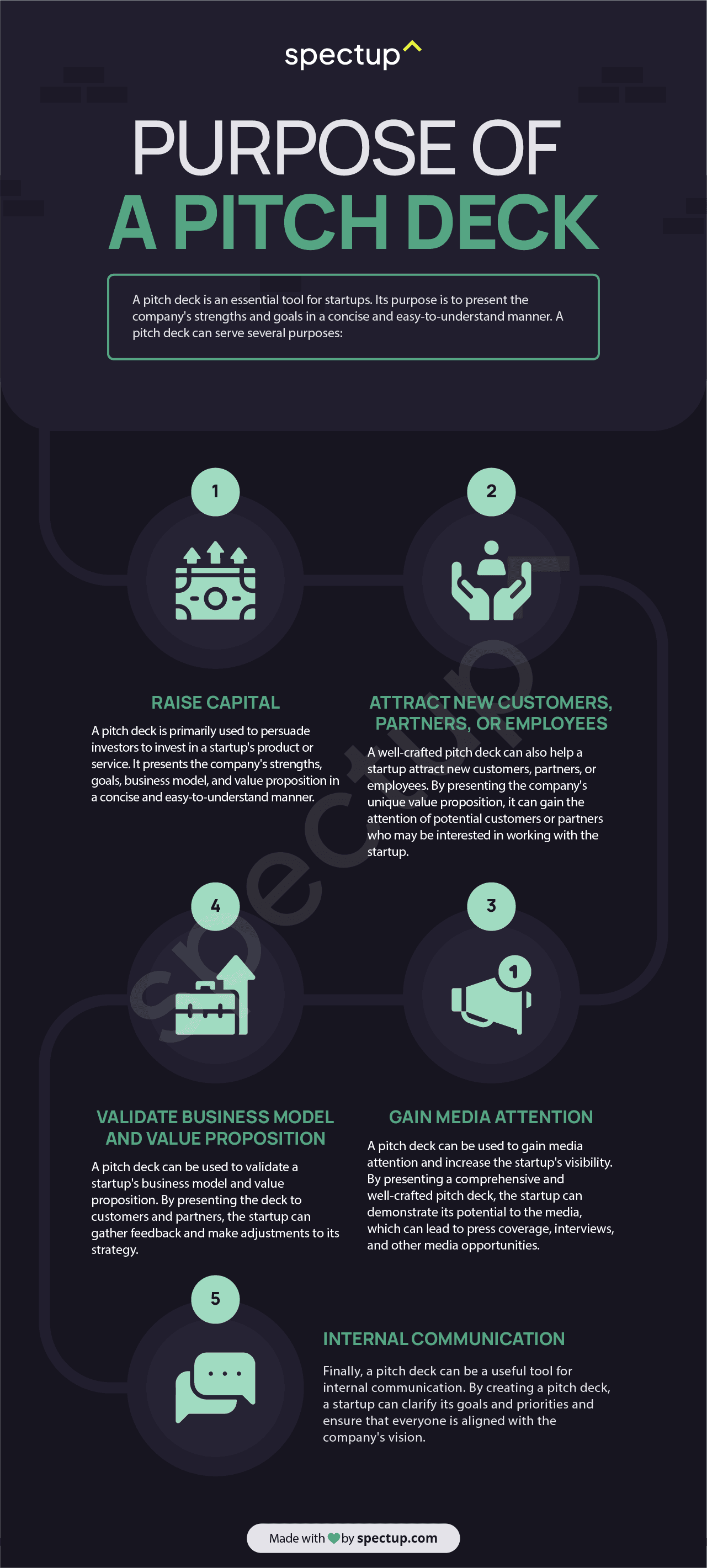
When and Why You Need a Pitch Deck
So, when does a pitch deck become your entrepreneurial ally? Here are some key situations:
Seeking External Capital: Whether you're approaching angel investors, venture capitalists, or other funding sources, a well-crafted pitch deck is essential.
Applying for Accelerator Programs: Many accelerator programs require a pitch deck as part of their application process.
Negotiating Client Contracts: A pitch deck can help articulate your business ideas succinctly and powerfully to potential clients.
It’s your chance to turn your data and dreams into a cohesive, compelling argument for why your business deserves to be the next big thing.
Key Components of a Pitch Deck
Alright, let’s dive in and break down the pitch deck anatomy, slide by slide. Think of it like the body’s organs – each one’s got a job, and together, they keep the whole show running smoothly. Your pitch deck? It’s the lifeblood of your business, and every slide is a pulse beat. Successful startup pitch decks from companies like Airbnb, Uber, and Facebook can serve as excellent examples. We'll show their decks later in this post.

1. Introduction Slide
Picture this: the lights dim, and the curtain rises. This is your opening act, the first glance that can hook your audience or make them yawn. You’ve got your company name, logo, and tagline up there, right? Great. Now, add a sprinkle of something unforgettable—a jaw-dropping stat or a one-liner that nails what you do with flair. Make them sit up straight and think, "Now, this is interesting."
Pro Tip: Start with a compelling story or a shocking statistic that immediately grabs attention.
Design Suggestion: Use bold, high-contrast colors for your company name and logo to ensure they stand out.
2. Problem Statement
Next up, we hit the problem statement. Think of it as showing a crack in the foundation that only you know how to fix. Be blunt, be clear. Toss in a relatable story or a vivid image to make them feel that crack deep in their bones. You’re not just pointing out a gap; you’re making them see the chasm.
Pro Tip: Use real-life examples or statistics to make the problem more tangible and relatable.
Design Suggestion: Incorporate a high-quality image or infographic that visually represents the problem.
3. Solution Overview
Now, you’re the hero swooping in to save the day. This is where you reveal your secret sauce. Lay out your unique selling points and make them pop. Use sharp visuals and crisp descriptions to show how your product isn’t just a band-aid, but a game-changer.
Pro Tip: Highlight the unique aspects of your solution that differentiate you from competitors.
Design Suggestion: Use icons or short video clips to illustrate key features of your solution.
4. Market Opportunity
Now, this is where investors start leaning forward. They want to see the gold at the end of the rainbow. Spell out the market size, break it into chunks, and show forecasts. Paint a picture of a market that’s ripe and ready for picking. It’s not just about big numbers; it’s about showing you’ve done your homework and know where to dig for treasure.
Define the market size and potential
Segment your target market
Provide forecasts
Paint a picture of a market ripe for the taking
Pro Tip: Use credible sources and data to back up your market size and potential.
Design Suggestion: Utilize bar graphs and pie charts to visually break down market segments and forecasts.
5. Product or Service Overview
Here’s your chance to shine. Go all out on the details—features, benefits, how it fits in the market. Don’t just tell; show. Use demos, screenshots, or testimonials. Make your product leap off the screen and into their hands.
Pro Tip: Use customer testimonials or case studies to add credibility to your claims.
Design Suggestion: Incorporate high-resolution screenshots or demo videos to showcase your product in action.
Pitch Deck Design Example 2 - made by spectup
6. Business Model
This is the nitty-gritty—how you’re gonna make bank. Break down your revenue streams, pricing, and anything unique about your model. Make it simple and clear. Investors want to see a well-oiled machine, not a jumbled mess.
Pro Tip: Clearly outline each revenue stream and its potential impact on your overall business.
Design Suggestion: Use flowcharts or diagrams to visually explain your business model.
7. Traction and Milestones
Here’s your proof in the pudding. Show them you’re not just talking the talk. Highlight your achievements, and back them with data. This slide is where your past wins set the stage for future glory.
Pro Tip: Use metrics that are most relevant to your business, such as user growth, revenue, or partnerships.
Design Suggestion: Include a timeline graphic to visually represent key milestones and achievements.
8. Marketing and Sales Strategy
How will you reach your customers? Your marketing and sales strategy slide should detail:
Your go-to-market plan
Sales channels
Marketing tactics
CRM plan to show investors you’re not just about attracting customers, but keeping them too.
This slide is your roadmap for turning prospects into profits, and it should be as detailed and strategic as your business plan itself.
Pro Tip: Highlight any unique or innovative marketing tactics that set you apart from competitors.
Design Suggestion: Use icons and flowcharts to depict different stages of your marketing and sales funnel.
9. Competitive Analysis
Acknowledge the battlefield. Show who’s out there and, more importantly, how you stand out. Use sharp comparisons and data to highlight your edge. Make it clear why you’re not just another face in the crowd.
Pro Tip: Use a SWOT analysis (Strengths, Weaknesses, Opportunities, Threats) to provide a comprehensive view of your competitive landscape.
Design Suggestion: Create a comparison table that highlights your advantages over competitors.
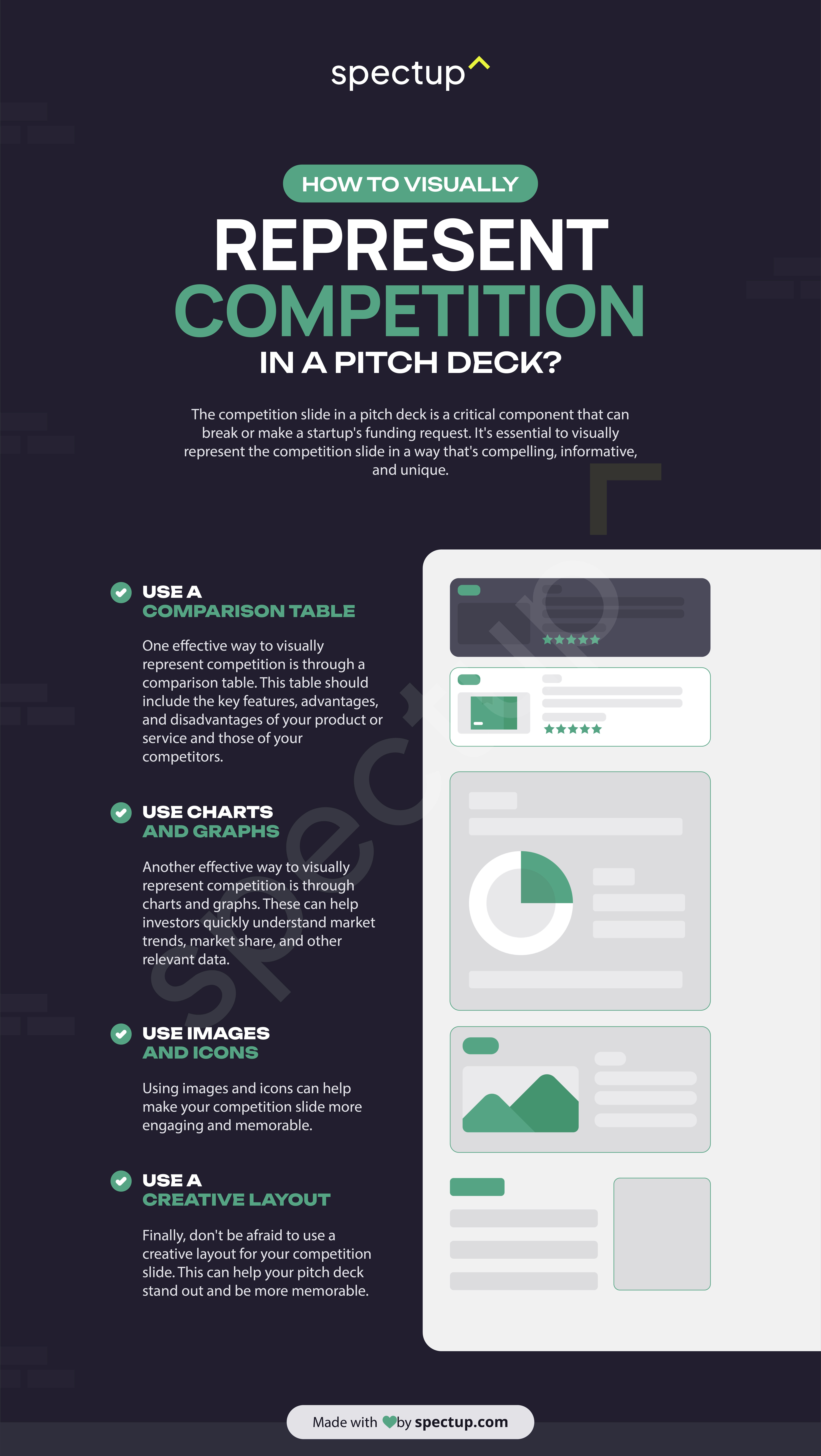
10. Team
Show off your dream team. Highlight their experience, skills, and what makes them perfect for your venture. It’s not just about resumes; it’s about showing investors that you’ve got the right crew to navigate the stormy seas of business.
Pro Tip: Focus on team members’ past successes and how their expertise directly benefits your startup.
Design Suggestion: Use professional headshots and brief bios to introduce each key team member.
11. Financial Projections
Now, let’s talk numbers. Forecast your financial future and map out your path to profitability. Be realistic, but optimistic. This slide should tell a story of growth and stability, backed by solid figures.
Pro Tip: Use conservative estimates to build trust with investors and avoid overpromising.
Design Suggestion: Incorporate line graphs and bar charts to visually represent your financial forecasts, making it easier for investors to grasp your projections at a glance.
And there you have it—the anatomy of a pitch deck, brought to life. At spectup, we’re all about helping you make these slides not just functional, but unforgettable. Let’s get out there and make some waves.
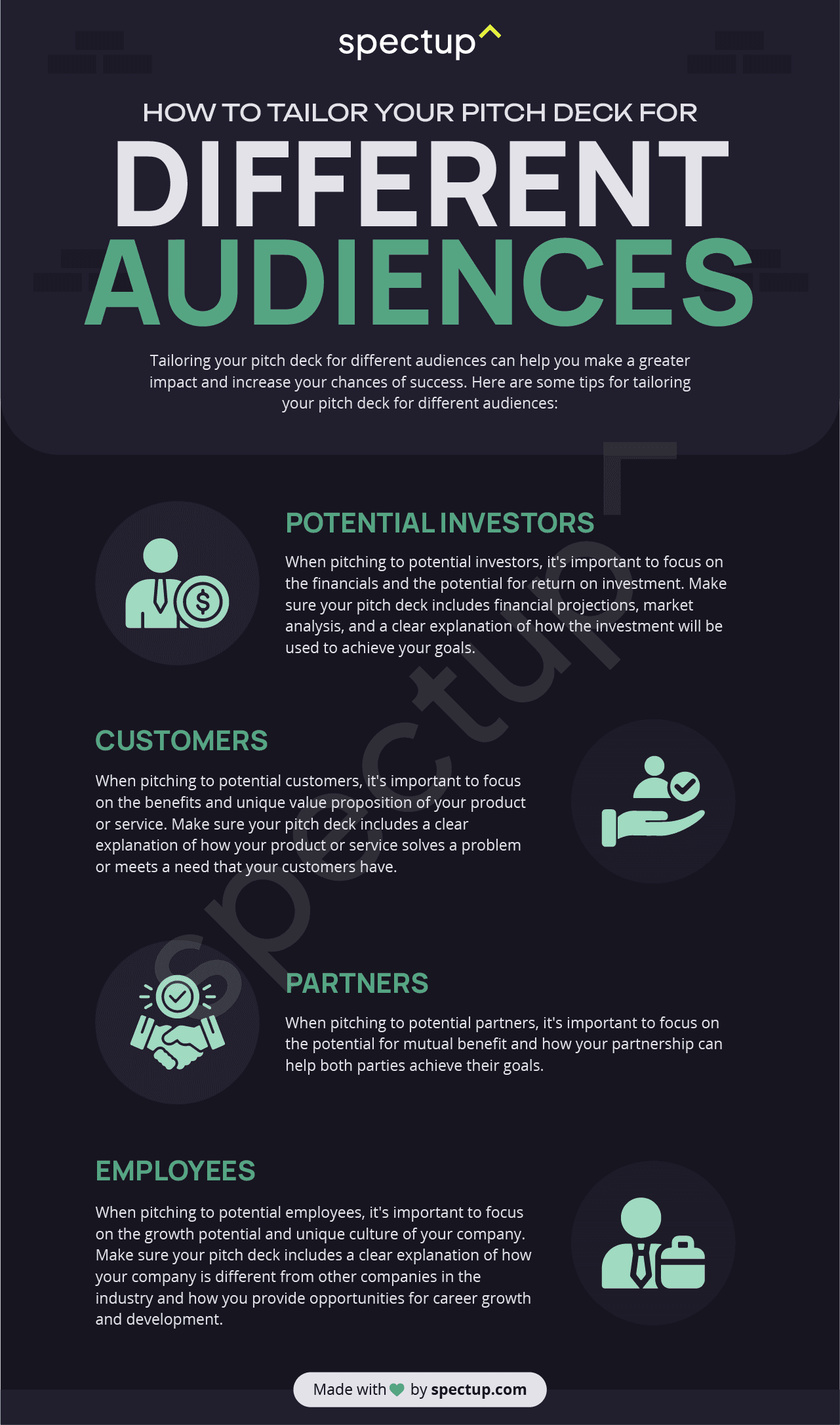
Adapting the Pitch Deck for Different Funding Stages
Alright folks, let’s talk pitch decks. Think of it like tailoring a suit—it’s got to fit just right depending on the occasion. Investors at different stages have different expectations. So, how do you tweak your pitch deck as your startup grows? Let’s dive in.
Seed Stage
When you’re at the seed stage, your pitch deck should be like a grand vision board. Investors are all about the potential. They want to see the problem you’re solving and any early wins that hint at a bright future. It’s your time to shine with big ideas and the promise of what’s to come.
Highlight the problem and your innovative solution
Showcase any early traction or user feedback
Outline the market opportunity and potential growth
Introduce your founding team and their expertise
Provide a high-level overview of your business model
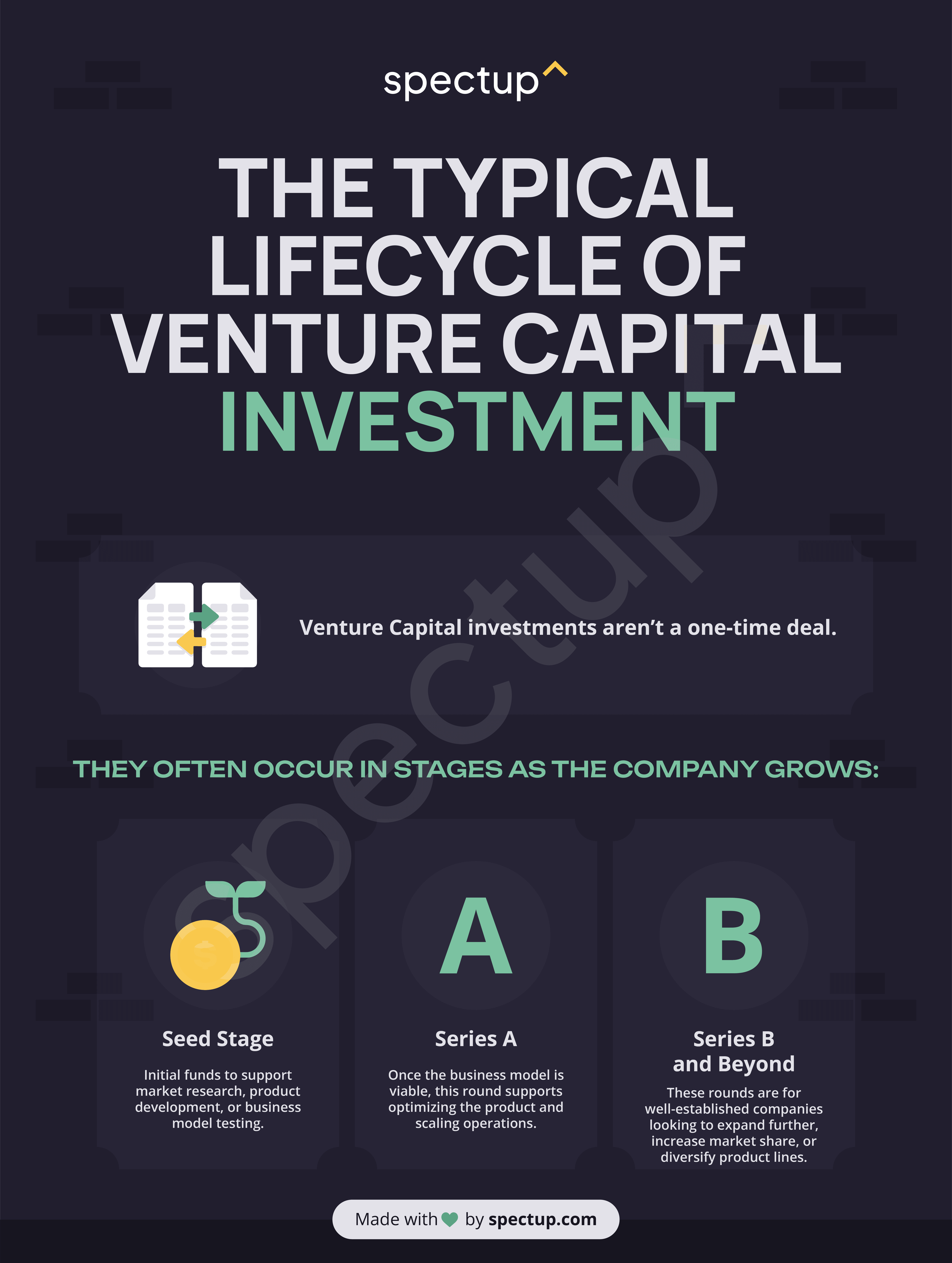
Series A
By the time you’re eyeing Series A, it’s go time. Investors are no longer satisfied with just ideas—they want proof. Your pitch presentation needs to show solid traction, a clear growth path, and a business model that screams profitability. This is your moment to prove you’re not just a dreamer, but a doer with numbers to back it up.
Present detailed traction and user metrics
Highlight significant milestones and achievements
Provide in-depth market analysis and competitive landscape
Demonstrate a scalable and profitable business model
Share financial projections and funding requirements
Series B and Beyond
Heading into Series B and beyond? Now, your deck should be a powerhouse of financials and growth metrics. Investors want to see scalability, market expansion strategies, and a team that knows its stuff. Here’s what they’re looking for:
Present in-depth financials, including detailed revenue and expense projections
Highlight growth metrics that prove you’re ready to dominate the market
Demonstrate a rock-solid business model that shows sustainable profitability
Showcase a seasoned, capable team with experience and expertise
Articulate a vision that’s both clear and expansive, outlining future growth and market penetration strategies
Types of Pitch Decks
Pitch decks aren’t one-size-fits-all. Different types serve different purposes. Let’s break them down.
E-Mail Pitch Decks
E-mail pitch decks are the detailed blueprints, full of key metrics and explanations. They’re designed to be read at an investor’s leisure, packed with information to stand on their own without you presenting.
Presentation Pitch Decks
When it’s time for a live show, your presentation pitch deck is your sidekick. Visually engaging with high-quality images and minimal text, these decks are made to complement your in-person pitch. Each slide should spark conversation and keep investors hooked.
Elevator Pitch Decks
Got just a minute? An elevator pitch deck distills your business into a few punchy slides. It’s all about making a big impact in a short time, focusing on your core message and value proposition.
Sales Pitch Decks
A sales pitch deck is your secret weapon to convert interest into action. It leads the audience through a narrative that includes:
Problem statements
Your solution
Value proposition
Key features
Demos
Pricing information
This deck is crafted to turn curiosity into commitment, and eventually, sales.
Product Pitch Decks
Launching a new product? Your product pitch deck should be thorough, laying out the go-to-market strategy and benefits to customers. It’s your chance to show off detailed descriptions, feature highlights, development timelines, and future updates.
Competition Pitch Decks
In the arena of startup competitions, your competition pitch deck is your sword and shield. It’s designed to spotlight innovation, scalability, and market impact. Successful decks in this category emphasize your unique selling points and competitive edge, using visuals and data to captivate judges and investors alike.
And there you have it! Tailoring your pitch deck to the right stage and type can make all the difference. It’s about showing investors not just where you are, but where you’re going—and making them want to come along for the ride. So, keep it fresh, keep it engaging, and most importantly, keep it you.
Common Mistakes to Avoid
Crafting a pitch deck is like walking a tightrope. One wrong step and, whoops, you’re tumbling down. Here are some common mistakes to steer clear of:
Overloading slides with information: Less is more, my friends.
Neglecting the visual design: Pretty matters. It really does.
A lack of focus on the key message: Keep your eyes on the prize.
Using too many slides: Quality over quantity.
Avoid these pitfalls to keep your pitch clear and punchy, ensuring your audience gets your message without feeling lost or overwhelmed.

Best Practices for Creating a Pitch Deck
Want your pitch deck to shine like a diamond? Here’s the secret sauce:
Keep it concise
Use visuals effectively
Weave a compelling story
Always personalize your pitch
These principles are your north star, guiding you to craft a pitch deck that’s not just informative but irresistible. Let’s unpack these best practices and see how they can transform your pitch into a memorable presentation.
Keep it Concise
Ever heard the saying, “Brevity is the soul of wit”? Well, it’s also the heart of a killer pitch deck. Aim for 10-15 slides, each with a single, sharp focus. Too much text or cluttered slides? Kiss your audience’s attention goodbye.
Every word should pull its weight, adding to your narrative without bogging it down. Make each slide a powerhouse of clarity and impact.
Use Visuals Effectively
A picture’s worth a thousand words, right? So, make those visuals work for you. Use images, charts, and graphs that not only catch the eye but also drive your point home. Strike a balance between text and visuals to keep your deck digestible and memorable.
Remember, visuals aren’t just for decoration. They should clarify and amplify your message, making complex ideas easy to grasp.
Tell a Compelling Story
Storytelling isn’t just for bedtime. It’s the heartbeat of engagement. Start with a hook that grabs your audience by the imagination and doesn’t let go. Build your narrative around the problem you’re solving and how your solution is the game-changer.
A good story makes your business pitch more than a stack of numbers—it turns it into an experience investors can’t resist being part of.
Personalize Your Pitch
Every investor is unique, and a one-size-fits-all approach won’t cut it. Tailor your pitch to reflect each investor’s interests and concerns. Show them you’ve done your homework and are committed to building a partnership that values their unique contributions.
By aligning your pitch with the investor’s perspective, you demonstrate not just business savvy, but a genuine interest in collaboration.
And there you have it! Avoid the common mistakes, embrace these best practices, and watch your pitch deck transform into a persuasive powerhouse. With a little finesse and a lot of passion, you’ll not only share your vision but sell it. So, go out there and make it happen, and remember, spectup's got your back every step of the way.
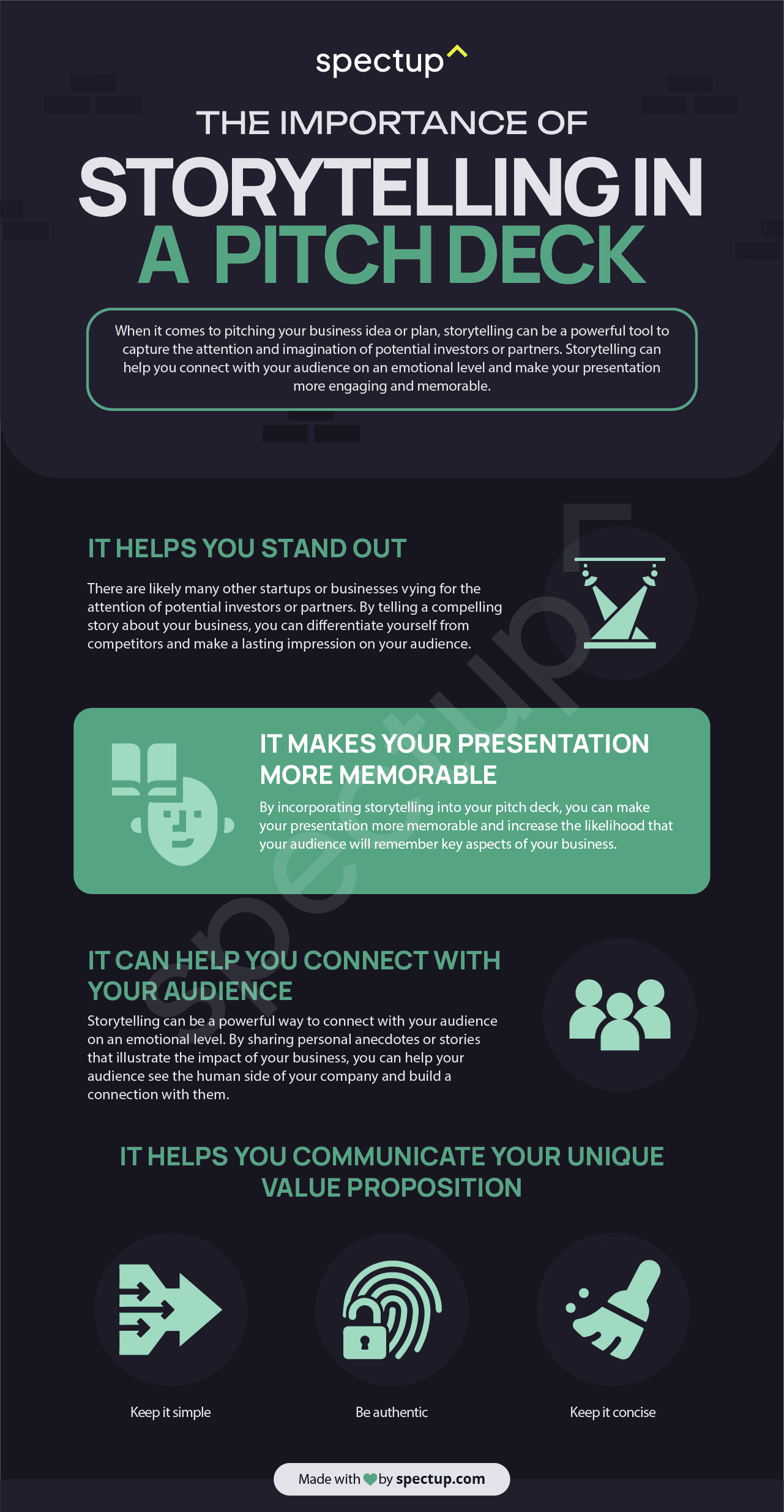
Learning from the Best: Masterclass Pitch Decks
Ever tried following a recipe from a top chef? Sometimes, seeing how the pros do it makes all the difference. The same goes for pitch decks. Some of the biggest names—Airbnb, Uber, Buffer, WeWork—nailed their presentations and have a lot to teach us.
Airbnb
Airbnb's pitch deck is like the Cinderella story of startups. They zeroed in on the high cost of hotels, presenting affordable lodging with local hosts as the perfect slipper. Their solution was simple yet game-changing, catering to a massive travel market. By showcasing rapid user adoption, they clearly highlighted a solid market fit. The result? Investors saw the immense opportunity waiting to be seized.
Conclusion: Airbnb's success lay in identifying a universal problem and presenting a straightforward, scalable solution.
Pro Tip: Focus on how your solution addresses a widespread issue and make sure your market fit is crystal clear.
Uber
Uber tackled a universal headache: unreliable and pricey transportation. Their on-demand ride-sharing model was a breath of fresh air. The pitch deck laid out a huge urban transportation market just waiting for disruption. By illustrating their expansion into multiple cities and a growing user base, Uber painted a vivid picture of a service the public was eager to embrace. They didn’t just promise change—they proved it was happening.
Conclusion: Uber's pitch deck effectively communicated their disruptive potential and rapid market adoption.
Pro Tip: Demonstrate how your business is already making an impact and show clear evidence of market demand.
Dropbox
Dropbox’s deck was all about solving the chaos of managing and sharing files across devices. Their efficient tool struck a chord with businesses and individuals overwhelmed by scattered documents. Highlighting strong user growth and engagement stats, Dropbox’s pitch deck showed clear traction and potential. It wasn’t just about the tool—it was about making file management less of a headache for everyone.
Conclusion: Dropbox’s pitch deck highlighted a specific pain point and showcased strong user engagement and growth.
Pro Tip: Use real user data and growth metrics to back up your claims and show your product's effectiveness.
Buffer
Buffer’s pitch deck zeroed in on a pain point many businesses face: managing social media efficiently. They offered a streamlined solution for scheduling posts, analyzing performance, and engaging with audiences. Their deck highlighted impressive user growth and retention metrics, proving that their tool was not just useful but essential for modern businesses. By presenting clear benefits and a strong market need, Buffer effectively demonstrated their value proposition.
Conclusion: Buffer’s success lay in addressing a common business challenge with a practical, user-friendly solution and backing it up with solid metrics.
Pro Tip: Focus on clear, tangible benefits and use data to support your claims, showcasing your product's indispensability.
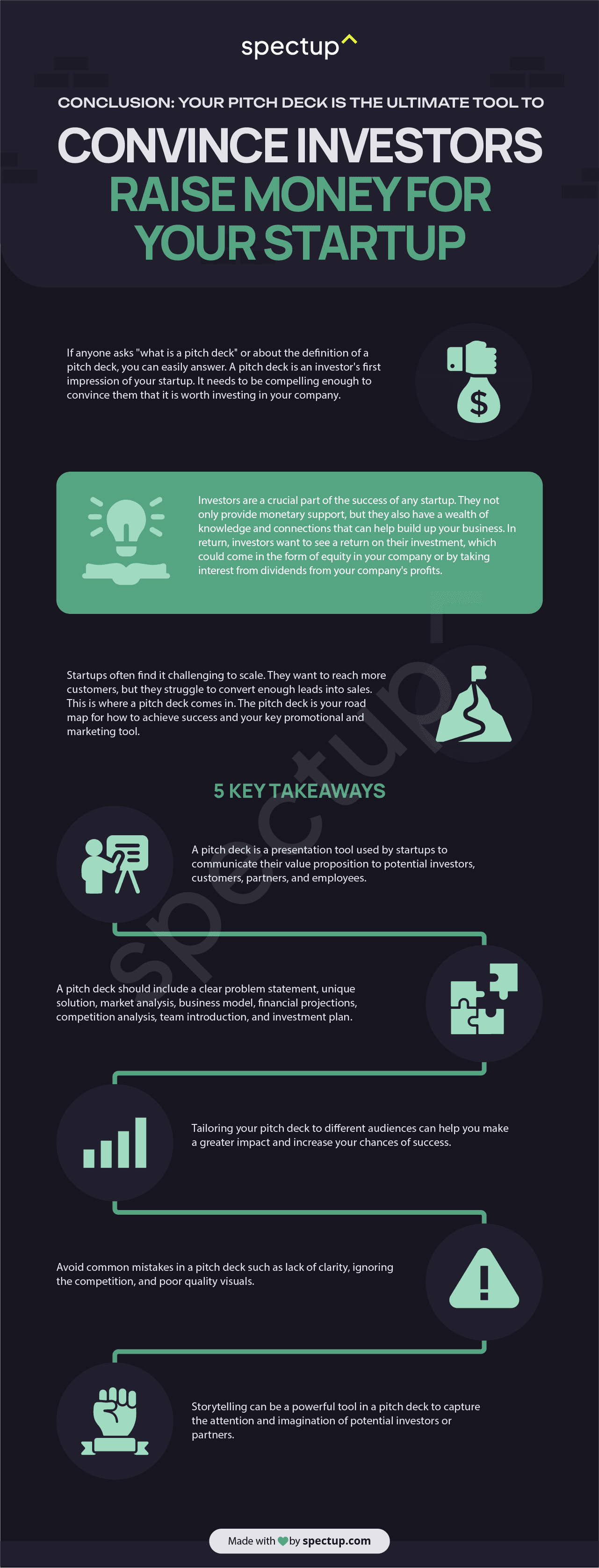
Hiring Pitch Deck Consultants
Sometimes, even the best need a bit of help. That’s where pitch deck consultants come in. These experts can add a layer of polish and professionalism that might just give your deck the edge it needs. Let’s look at when to call in the pros, the benefits they bring, and how to pick the right one.
When to Consider Hiring a Consultant
Knowing when to bring in a pitch deck consultant is crucial. If you’re wrestling with a lack of in-house expertise, running short on time, or facing a high-stakes investor pitch, a consultant can step in. They’re particularly handy when you’ve got investor pitches lined up but your deck still needs that professional touch.
Benefits of Professional Assistance
Here’s what a good consultant brings to the table:
Expert design and storytelling skills
Enhanced credibility for your pitch deck
Comprehensive market research
Refined brand messaging
Accurate financial projections
Tailored strategies for different funding stages
These elements make your deck more persuasive, boosting your chances of securing investment.
How to Choose the Right Consultant
Picking the right consultant isn’t just about fancy titles. Look for:
Experience in your industry
A portfolio of successful pitch decks
An understanding of your business and industry
Positive references and client testimonials
A good reputation
Clear terms for revisions, pricing, and confidentiality
Make sure you also agree on clear terms for revisions, pricing, and confidentiality. This ensures a smooth collaboration and a pitch deck that truly shines.
Tools and Resources for Creating Pitch Decks
Alright, folks, let’s talk about making your pitch deck as smooth as butter. With the right tools and resources, this daunting task can actually become pretty manageable. Here’s the lowdown on some fantastic options to help you craft a pitch deck that’ll wow any investor.
Presentation Software
Your pitch deck’s backbone is good presentation software. Here are a few you might want to consider:
PowerPoint: This one's the granddaddy of them all. Robust features, easy to use, and versatile.
Google Slides: Perfect for collaborative work. It’s cloud-based, so you can work from anywhere and with anyone.
Beautiful.ai: Uses AI to help design, making your slides look professional with minimal effort.
Prezi: Offers dynamic, non-linear presentations that can captivate your audience.
Pitch: Focused on team collaboration, making it easy to work together on your deck.
Mentimeter: Keeps your audience engaged with interactive elements like polls and quizzes.
Picking the right software can take your pitch deck from “meh” to marvelous.
Template Libraries
Sometimes you need a little jumpstart. That’s where template libraries come in. Here are some platforms offering a ton of customizable designs:
Canva: User-friendly with a wide range of professional templates.
Visme: Packed with customizable templates and design elements.
SlidesCarnival: Offers free, high-quality templates for various presentation needs.
Envato Elements: Provides access to a vast library of premium templates and design assets.
Template.net: Features a variety of templates for different business needs.
These tools are user-friendly and packed with professional templates, letting you create a stunning pitch deck without needing a design degree.
Design Services
Not feeling the DIY route? No worries. Design services can take the reins. Here are some options:
spectup: Offers comprehensive services beyond just design, including market research, copywriting, and storytelling expertise.
Slidebean: Provides ready-made templates and design assistance, making the process even smoother.
Haiku Deck: Focuses on creating beautiful, simple presentations quickly.
Killer Infographics: Specializes in creating visually striking infographics and presentations.
24Slides: Offers custom presentation design services tailored to your needs.
These services can help you create a pitch deck that’s not just functional, but unforgettable.

Conclusion: What is a Investor Deck
So, what’s the big takeaway here? Your pitch deck is more than just a bunch of slides—it’s a strategic tool that captures your business's essence and potential. By mastering the key components, tailoring your deck for different funding stages, and sidestepping common pitfalls, you can create a pitch that stands out. And don’t forget to leverage the right tools, resources, or even professional consultants to refine your presentation.
Now, with these insights in your toolkit, you’re ready to craft a pitch deck that not only tells your story but turns listeners into believers and believers into investors.
Niclas Schlopsna
Partner
Ex-banker, drove scale at N26, launched new ventures at Deloitte, and built from scratch across three startup ecosystems.








